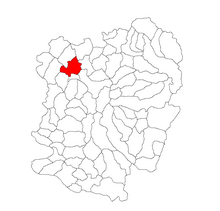Bocșa
|
Bocșa Bokschan Boksánbánya |
||||
|
||||
| Basic data | ||||
|---|---|---|---|---|
| State : |
|
|||
| Historical region : | Banat | |||
| Circle : | Caraș-Severin | |||
| Coordinates : | 45 ° 23 ' N , 21 ° 44' E | |||
| Time zone : | EET ( UTC +2) | |||
| Height : | 170 m | |||
| Area : | 121.57 km² | |||
| Residents : | 15,842 (October 20, 2011) | |||
| Population density : | 130 inhabitants per km² | |||
| Postal code : | 457045 | |||
| Telephone code : | (+40) 02 55 | |||
| License plate : | CS | |||
| Structure and administration (as of 2016) | ||||
| Community type : | city | |||
| Mayor : | Gabriel Eugen Cismăneanțu (Partidul Mișcarea Populară) | |||
| Postal address : | Str. Principală, no. 23 loc. Bocșa, jud. Caraș-Severin, RO-457045 |
|||
| Website : | ||||
Bocşa ( ; German Bokschan , Hungarian Boksánbánya ) is a town in the Caraş-Severin district in the Romanian Banat .
Geographical location
Bocşa is located in the Banat in the valley of the river Bârzava between the Dognecea Mountains in the south and the mountain Tâlva Înaltă ( 370 m ) in the north. The district capital Reșița is located about 15 km southeast.
Neighboring places
| Berzovia | Sacoșu Mare | Găvojdia |
| Deta |

|
Caransebeş |
| Jamu Mare | Anina | Reșița |
history
The area of today's city originally consisted of three villages, namely Bocșa Montană (German: German Bokschan ), Vasiova (German Wassiowa ; Hungarian Vassafalva ) and Bocşa Româna (German: Romanian Bokschan , Hungarian Várboksán ). After the Second World War, Bocşa Montană and Vasovia were combined to form the Bocşa Vasoviei municipality (now the Bocşa I district). This was merged in 1961 with Bocşa Româna (now Bocşa II district) to form the city of Bocşa.
The first written mention of Bocşa (later Bocşa Româna) comes from 1333. 1437 Vasiova is also documented. Bocşa Castle was mentioned in 1534. During the Turkish rule in the 16th and 17th centuries, iron and copper were mined in the vicinity of Bocşas. After incorporation into the Habsburg Empire , Austrian miners resumed mining in 1703. As a result, the mining town of Deutsch-Bokschan developed above Bocşa Românas. In 1719, an ironworks and the first state iron manufacture in Southeast Europe, called "Altwerk", were built in Deutsch-Bokschan to process the iron ore mined in the Dognecea Mountains and near Eisenstein (Rum. Ocna de Fier ; Hungarian Vaskö ). In 1722 another manufacture was built, the "Neuwerk". Around this a settlement developed, the New German Bokschan (Rum. Bocşa Montană Nouă ; ung. Újboksánbánya ) was called. Iron ore was also brought to Bocşa from Lupak (Rum. Lupac , Hungarian Kiskrassó ) and the Semenic Mountains .
In the meantime, the ironworks was leased from the Vienna Court Chamber into private hands, but then taken over again by the state and in 1855 the new ironworks built at the end of the 18th century were sold to the Austrian State Railway Company. After 1873, the hut lost its importance and ceased operations. In 1898 a factory for the manufacture of agricultural equipment was established. After the First World War, most of the Banat and also the area of today's city of Bocşa came to Romania.
After the Romanian Revolution of 1989 , the economic upheaval led to a change in the population structure, in particular to an influx of socially disadvantaged families, especially Roma . This was associated with an increase in the crime rate and poor hygienic conditions, especially in Bocșa II.
The main industries in the city are still metal construction and the production of agricultural implements.
population
In 1717 there were 82 houses in Bocșa Româna and 32 in Vasiova. In 1880 there were 6,426 people living in the area of today's city, 4588 of them Romanians , 1186 Germans and 178 Hungarians . In 1977 the largest population was determined with 20,731. In the 2002 census, 16,911 inhabitants were registered in the city, including 15,041 Romanians, 643 Roma, 596 Hungarians, 432 Germans, 64 Slovaks , 61 Serbs , 28 Ukrainians and 17 Czechs .
traffic
Bocșa is located on a branch line from Reșița to Voiteg (Voiteni station). There are four stops in the city. The route is operated by the private rail company Regiotrans . National road 58B leads through the city from Voiteg to Reșița.
Attractions
- Monastery of St. Ilie (1905)
- Buza Turcului castle ruins
- Landscape of the Dognecea Mountains
Personalities
- Corneliu Diaconovici (1859–1923), publicist
- Petru E. Oance (1881–1973), alias Tata Oancea , poet and sculptor
- Zeno Vancea (1900–1990), composer and musicologist
- Sorin Frunzăverde (1960–2019), politician
See also
- List of German and Hungarian names of Romanian places
- Portal: Romania / List of localities in the Banat
literature
- Elke Hoffmann, Peter-Dietmar Leber and Walter Wolf : The Banat and the Banat Swabians. Volume 5. Cities and Villages , Media Group Universal Grafische Betriebe München GmbH, Munich, 2011, 670 pages, ISBN 3-922979-63-7 .
Web links
Individual evidence
- ↑ 2011 census in Romania ( MS Excel ; 1.3 MB)
- ↑ Mayoral elections 2016 in Romania ( MS Excel ; 256 kB)
- ^ Banat Update 1996, accessed December 12, 2008
- ↑ 2002 census, accessed December 12, 2008
- ↑ Alex. Ştefănescu: Cornel Ungureanus information on "Petru E. Oance" in România Literară, 15th edition 2000 ( memento of March 4, 2016 in the Internet Archive ) accessed on September 1, 2012 (Romanian)



